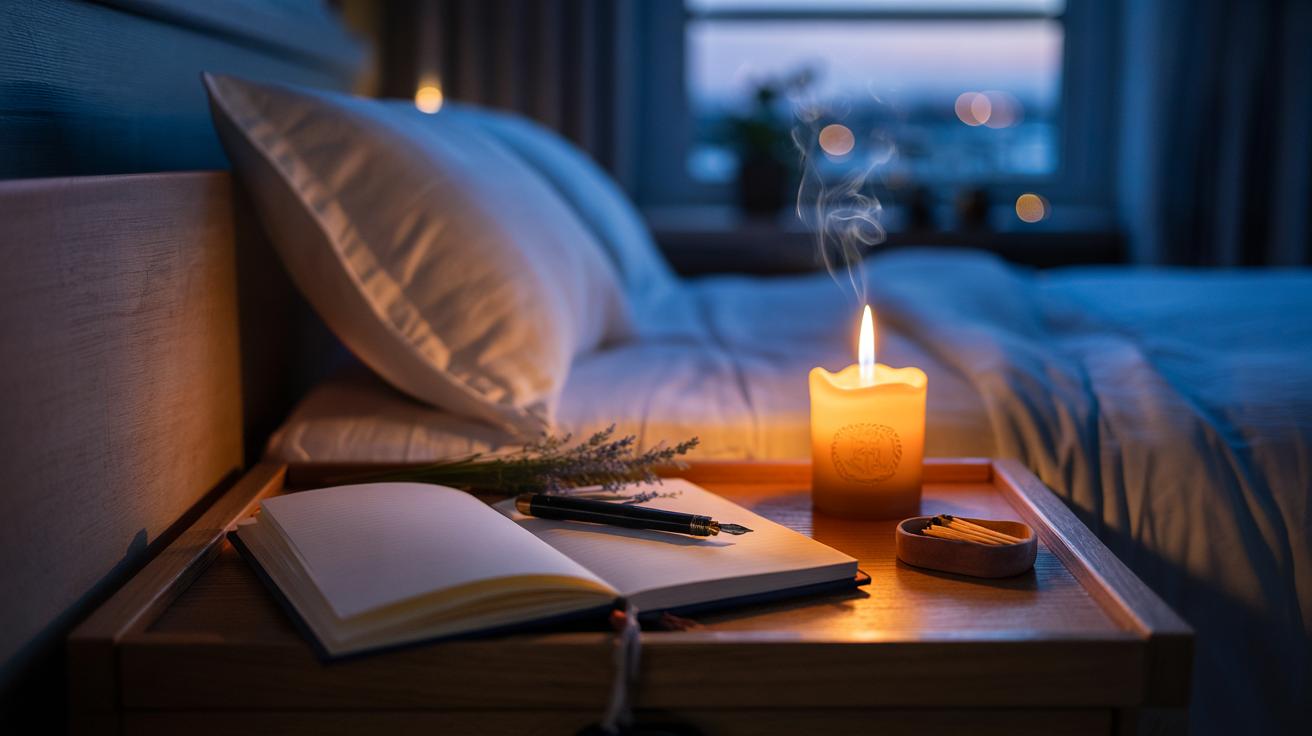In a nutshell
- 🕯️ The candle’s scent and warm light engage the limbic system and reduce blue-spectrum alertness, cueing the parasympathetic nervous system to wind down.
- 📝 Journaling provides cognitive offloading and affect labelling, containing worries and clarifying priorities to ease rumination and prepare for sleep.
- 🔁 Repeating the pairing creates a habit loop—cue, routine, reward—conditioning a reliable evening shutdown with less reliance on willpower.
- ⏰ Consistent cues support the body clock and neuroception of safety, shortening sleep onset latency and smoothing the transition from work to rest.
- 🧰 Practical setup—single-note scents (lavender, bergamot, cedar), dim placement, and fixed opening/closing phrases—builds a simple, safe, and repeatable ritual.
There is a quiet power in pairing a candle with a journal at the end of the day. As the wick takes, the room softens; pen meets paper, and the mind follows suit. This simple duet sends unmistakable signals that the day is closing. The warm glow dims stimulation while scent touches the limbic system, and writing performs gentle cognitive offloading. By stacking sensory cues with reflective language, you carve a threshold between public pace and private rest. The result is not a performance but a reliable pattern: a repeatable way to soothe the nervous system, decant thoughts, and make sleep less of a struggle and more of an invitation.
Why Scent and Script Calm the Nervous System
The sense of smell has a direct line to the brain’s emotional core. Light a candle and volatile compounds meet the olfactory bulb, which speaks swiftly to the amygdala and hippocampus. That is why a lavender or cedar note can feel like a shortcut to calm. Low, amber light also reduces alerting blue spectrum input, coaxing the parasympathetic nervous system forward. When scent pairs with script, the brain reads intent: this is the evening wind-down, not another task. The pairing reframes the room and, crucially, your physiology. It is a sensory cue, not a moral demand.
Journaling works on a different but complementary lane. Putting worries into words dampens rumination and lowers perceived threat, a process researchers call affect labelling. It can nudge down cortisol while restoring a sense of control. The page becomes a container; attention narrows; breathing deepens. Write three lines of what mattered, or list one thing you will leave for tomorrow. By externalising thought, you give the body permission to stand down. The candle sustains the mood, the pen carries the mind; the two together make the ritual memorable and repeatable.
How Rituals Train the Brain to Switch Off
Ritual is behaviour with meaning attached. Repeat the same steps at a similar time and your brain builds a habit loop: cue, routine, reward. The cue is spark and scent; the routine is five to ten focused minutes of writing; the reward is tension easing and a clearer head. Over days, the loop requires less effort to start. Consistency turns a pleasant idea into a conditioned response. That matters at bedtime, when attention is easily hijacked by screens or worry. You are teaching your system to recognise closing signals without needing willpower every night.
There is also a circadian benefit. A fixed wind-down ritual acts like a lighthouse for your body clock, especially when paired with dimmer light and reduced stimulation. Neuroscientists talk about neuroception of safety—the subconscious assessment that the environment is secure. A stable sequence of benign cues—faint fragrance, soft shadow, scratch of nib—feeds that appraisal. Safety switches on rest-and-digest, sharpening the gradient into sleep. Over weeks, the ritual’s predictability can reduce sleep onset latency and smooth the emotional residue that often trails in from the working day.
Setting the Scene: Lighting, Layout, and Language
Design the ritual as you would lay a table. Place the candle at eye level but out of your direct line of sight to avoid glare. Choose soy or beeswax for a clean burn; aim for single-note scents like lavender, bergamot, or cedar to keep the signal distinct. Keep the journal and pen within easy reach so there is no friction in starting. Begin with a consistent opener—“Today I noticed…”—and end with a gentle closer—“Tomorrow can wait.” Never leave a candle unattended, and snuff rather than blow to maintain a sense of ceremony without the theatrical smoke.
| Sensory Cue | Signal and Effect |
|---|---|
| Warm candlelight | Indicates dusk; reduces alertness; eases transition to parasympathetic state |
| Recognisable scent | Tags the moment in olfactory memory; accelerates emotional downshift |
| Pen on paper | Performs cognitive offloading; quiets rumination; clarifies priorities |
| Closing phrase | Marks completion; reduces looping thoughts; anchors the ritual’s reward |
Keep language brief and kind. Aim for two or three short paragraphs or a bulleted trio: one win, one worry named without judgment, one intention to release. Let the page be a boundary rather than a battlefield. Over time, you will crave the association: scent means settling, light means landing, ink means end-of-day sense-making. That is the subtle architecture of rest built from ordinary parts—small, human, and robust.
The candle-and-journal pairing is not a luxury; it is a simple technology for signalling closure. Scent engages emotion and memory, light reshapes the room’s tempo, and writing resets the mind’s narrative. Together, they compress the distance between a hectic evening and a restorative night. The best ritual is the one you can repeat—same chair, same candle, same two minutes to write what you will carry and what you will kindly set down. When the cues are clear, the body cooperates. Which fragrance, phrase, and page format will you choose to mark the day’s end tonight, and what might change if you kept it for a month?
Did you like it?4.5/5 (23)
